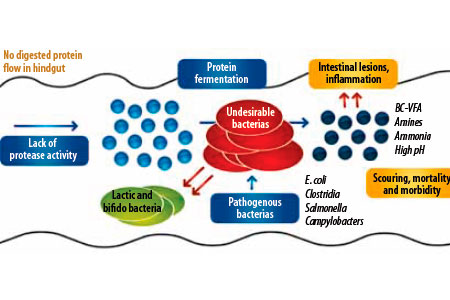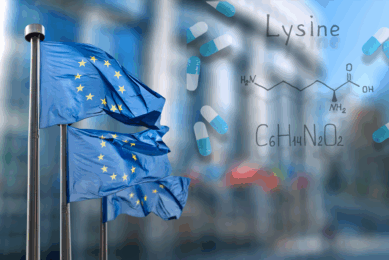Protease enzymes and the benefits beyond cost savings

Protease enzymes improve the digestibility and availability of proteins, optimising diet costs by allowing lower quality protein alternatives to be used in the diet. This helps save on feed costs, as grain and oilseed meal prices continue to fluctuate. Researchers have also been digging into the additional benefits of the protease enzyme and its link to gut health and bacteria balance in poultry and swine.
By Marc Decoux, executive manager, Poultry Applied Solutions, Novus International, USA
Protease enzymes are an important factor in protein digestion as they hydrolyse the less digestible proteins in animal feeds and break them down into more usable peptides. Improving dietary protein digestibility with a quality protease can reduce feed cost by allowing the use of lower crude protein feedstuffs with lesser quality amino acids, effectively lowering protein and digestible amino acids levels required from the feedstuffs up to 10%.
Recent research in poultry and swine has shown that supplementing diets with a protease enzyme support gut health and optimise animal performance compared to non-protease supplemented diets. Understanding the antinutritional effect of indigestible proteins in the hindgut of the animal helps explain this effect (Figure 1- see attached pdf).
Alternative protein sources to soybean meal (SBM), such as Cottonseed Meal (CSM) and Corn Distillers Dried Grains with Solubles (DDGS) can have lower quality protein levels and reduced digestibility. Supplementing protease helps monogastrics that lack adequate levels of endogenous enzymes to digest proteins in the diet, which reduces the flow of undigested protein and other anti-nutritionals entering the large intestine. This indigestible protein serves as a fermentation substrate for undesirable bacterial strains, such as Escherichia coli, Clostridium perfringens, Salmonella and Campylobacter in the gut. The proteins will be used by these harmful bacteria as nutrients. These pathogenic bacteria can then increase in population, shifting the balance of intestinal microflora against beneficial strains.
Pathogenic bacteria can also produce toxic components such as bacteriotoxins, but also fermentation metabolites like biogenic amines, ammonia and volatile sulphur compounds. All of which can be detrimental to performance by favouring oxidative stress, intestinal inflammation and lesions increasing both mortality and morbidity rates.
Gut morphology
Villi increase surface area for absorption by the intestinal wall. Measuring the intestinal villus height to crypt depth ratio is a standard parameter to identify the gut’s efficiency. The higher the ratio, the better the intestine is functioning. Wang and others studied the effect of a serine-protease derived from Bacillus licheniformis PWD-1 fermentation, on gut morphology in broilers with two protein sources.
One group of broilers was fed SBM as a digestible protein and a second group CSM as an indigestible protein. The CSM-fed group had a damaged intestinal morphology, suggesting a higher rate of protein fermentation and more intestinal challenges. Results show that, regardless of the protein source, adding protease to the diet significantly increased the gut’s efficiency. It overcame the negative effects of the CSM.
The left-hand photo in Figure 2 (see attached pdf) is from a group that was fed CSM without a protease. It shows a damaged intestine with small, misshapen villi and deeper crypts. The image on the right from the protease supplemented group highlights a gut morphology that is more adequate for nutrient absorption, with tall villi exhibiting uniform height and shorter crypts as compared to the control.
In 2012, Yan and other researchers tested the effect of a protease supplement in broilers challenged with a triple-dose coccidiosis vaccine and fed high protein diets. The control group was fed a standard, 22% protein diet. The other group was fed an excess of protein at a 30% level to specifically provoke a flow of indigestible protein in the hindgut and measure the impact of adding protease.
As previously mentioned, fermented proteins can promote the growth of harmful bacteria in the gut – this study measured C. perfringens levels. When the protein content of the feed was increased, there was a significant increase of C. perfringens (Figure 3 – see attached pdf). However, when protease was added with the additional protein, pathogenic bacteria on the fermented protein reduced compared to the control group.
Protease enzymes helped overcome several of the negative effects of protein fermentation by breaking down proteins in the feedstuffs. In addition to helping reduce pathogenic bacteria, it also reduced the secretion of acute-phase protein. Levels of serum α-1-acid glycoprotein were measured to indicate gut barrier function and inflammation. Study results show that adding protease to the high protein diet significantly improved the inflammatory status of the animals.
Enhanced performance
One of the most significant findings of the research resulted from measuring the overall performance index of the birds. The performance index is calculated by multiplying livability (percentage of birds alive at day 28) by body weight then dividing by feed to gain ratio. By adding a protease to the high protein diet, animal performance improved by 21%. Previous findings suggest this is not just due to better digestibility – it also is linked to reduced inflammation, improved gut morphology and less fermented protein.
Protein challenges for piglets
Research has been done with protease in piglets as well. While most proteins in SBM are easily digested in older pigs, newly weaned pigs lack endogenous protease activity and therefore some proteins are especially difficult for them to digest. Piglets are also very sensitive to excess protein fermentation in the intestine.
The challenge for nutritionists is that piglets have high requirements for digestible proteins to promote early growth and muscle deposition. However, as mentioned earlier, high protein diets pose a lot of problems with pathogenic bacteria causing scours, intestinal disorders and morbidity. While common practice is to lower the protein level in feed to reduce health problems, it’s at the expense of growth and performance. SBM also contains the allergenic proteins glycinin and ß-conglycinin, which cause intestinal inflammation and lead to villus atrophy, disruption of gut barrier functions and loss of appetite. Low feed intake in piglets is very dangerous and leads to overall low performance.
Improved gut health
Wang and others published research results in 2011 showing the effect of serine-protease on nutrient utilisation, gut health and performance during the 21 days after weaning. A group of nursery pigs was fed a control diet with 19% protein with and without protease and the other group a high protein diet (22%) with and without protease.
Study results show a higher performance when supplemented with protease; an enhanced growth and 14% better feed efficiency regardless of the protein content. Part of the reason for that is the improved digestibility. But researchers also found that protease was able to break down 90% of the allergenic components of the SBM in vitro, which may be another reason why the protease-supplemented piglets performed better. Using protease also allows for improved intestinal functions by supporting a better morphology as evidenced by improved villus height to crypt depth ratio in this study.
Similar to the results in broilers, using protease for piglets reduced protein fermentation and limited the growth of pathogenic bacteria in the intestine – in this case, E. coli. Reduction in total E. coli can result in fewer health problems. That shows in the results of faecal score tests (Figure 4 – see attached pdf). When a protease is added to the diet, there is no difference in faecal scores between the low and high protein diets, when typically faecal scores would be much higher, i.e. worse, in a high protein diet.
While the main reason for including enzymes in poultry and swine diets has been to reduce ration costs, these study results show that adding a highly efficient serine-protease supplement can also optimise health and performance, adding more value for producers.











